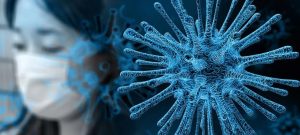Written by Joyce Smith, BS. Study details how an air disinfection system utilizing heated Ni-foam filters are capable of effectively trapping and killing airborne SARS-CoV-2 and Bacillus anthracis spores.
 Severe acute respiratory syndrome (SARS-CoV-2), commonly referred to as COVID-19, has evolved into a worldwide pandemic 1, infecting more than 7.4 million people and causing 418,294 deaths 2. The highly infectious, asymptomatic virus sheds for days, is very resilient in many environments 3,4 and very capable of rapid human-to-rapid human transmission 5,6.
Severe acute respiratory syndrome (SARS-CoV-2), commonly referred to as COVID-19, has evolved into a worldwide pandemic 1, infecting more than 7.4 million people and causing 418,294 deaths 2. The highly infectious, asymptomatic virus sheds for days, is very resilient in many environments 3,4 and very capable of rapid human-to-rapid human transmission 5,6.
A current study found that when simulated aerosols and larger droplets of SARS-CoV-2 were compared to those of SARS-CoV-1 (the closely related 2003 strain), SARS-CoV-2 remained viable in the air for 3 hours and in larger droplet form was viable on surfaces for several days 7. In spite of staff adherence to strict protocols to prevent viral spread in a Wuhan hospital, residual RNA was detected in a hospital location that pointed to the ventilation system, prompting a team of researchers 8 to seek a solution. With the loosening of social distancing regulations and people returning to work they saw the potential for increased aerosol spread in air-conditioned spaces and were motivated to develop an air filter with the potential to trap and destroy the airborne Covid-19 virus.
Since the virus cannot survive temperatures above 70 degrees Centigrade (°C), the equivalent of 158 degrees Fahrenheit (°F), researchers constructed a prototype filter using nickel foam (Ni-foam) for its flexibility, porosity (pores small enough to trap the virus, and electrical conductivity. By folding the foam and threading it with electrical wires, they were able to achieve sufficient electrical resistance to achieve temperatures as high as 250 °C which would destroy the virus in a very short time.
The Galveston National Laboratory, run by the University of Texas Medical Branch, tested the prototype filter. When the Ni- foam was heated to 200 ° C (about 392 ° F), 99.8% of SARS-CoV-2 was destroyed in a single pass through of the filter. A similar prototype filter was designed to destroy anthrax spores which, when tested, destroyed 99.9% of Bacillus antiracism spores. Bacillus anthracis is a large (1-1.5 am × 3-10 am in size), aerobic, gram-positive, airborne spore that has for some time been considered a biological warfare agent 9. Unheated filters functioning as controls were tested as well; however, while the reduction was also effective the virus was not killed by the unheated filters.
Researchers believe this virus-trapping air filter may have many practical applications for both essential workers and the general public in our current COVID-19 pandemic. A phased roll-out of the Ni- filter has begun, with priority given to essential workers, particularly for those in hospitals and healthcare facilities where exposure levels are very high. Public transportation such as airplanes, buses and trains could also minimizing the risk of SARS-CoV-2 exposure through the use of this innovative technology. The development of a mobile air-purification device that could be carried on one’s person in order to maintain clean personal air space would reduce exposure risk when people are in close proximity to each other such as at airports as well as in airplanes, office buildings, schools and even cruise ships. A small desk-top model capable of purifying the air in an office worker’s or a classroom environment could potentially be very useful to both society and the economy in preventing airborne spread of COVID-19. Finally, this technology could be used in the manufacturing of safe bio agent protection gear to eliminate future bioterrorism threats from airborne infectious agents such as anthrax.
Source: Yu, Luo, Garrett K. Peel, Faisal H. Cheema, William S. Lawrence, Natalya Bukreyeva, Christopher W. Jinks, Jennifer E. Peel et al. “Catching and killing of airborne SARS-CoV-2 to control spread of COVID-19 by a heated air disinfection system.” Materials Today Physics (2020): 100249.
© Copyright holder (which was not certified by peer review) is the author/funder. All rights reserved. No reuse allowed without permission.
Posted July 28, 2020.
Joyce Smith, BS, is a degreed laboratory technologist. She received her bachelor of arts with a major in Chemistry and a minor in Biology from the University of Saskatchewan and her internship through the University of Saskatchewan College of Medicine and the Royal University Hospital in Saskatoon, Saskatchewan. She currently resides in Bloomingdale, IL.
References:
- Wang C, Horby PW, Hayden FG, Gao GF. A novel coronavirus outbreak of global health concern. Lancet. 2020;395(10223):470-473.
- WHO. Coronavirus disease (COVID-19) pandemic. 2020; https://www.who.int/emergencies/diseases/novel-coronavirus-2019. Accessed July 21, 2020.
- Anderson RM, Heesterbeek H, Klinkenberg D, Hollingsworth TD. How will country-based mitigation measures influence the course of the COVID-19 epidemic? Lancet. 2020;395(10228):931-934.
- Yadav M. Understanding the epidemiology of COVID-19. European Journal of Biological Research. 2020;10(2):105-117.
- Li C, Ji F, Wang L, et al. Asymptomatic and Human-to-Human Transmission of SARS-CoV-2 in a 2-Family Cluster, Xuzhou, China. Emerg Infect Dis. 2020;26(7):1626-1628.
- Song R, Han B, Song M, et al. Clinical and epidemiological features of COVID-19 family clusters in Beijing, China. The Journal of infection. 2020.
- van Doremalen N, Bushmaker T, Morris DH, et al. Aerosol and Surface Stability of SARS-CoV-2 as Compared with SARS-CoV-1. The New England journal of medicine. 2020;382(16):1564-1567.
- Yu, Luo, Garrett K. Peel, Faisal H. Cheema, William S. Lawrence, Natalya Bukreyeva, Christopher W. Jinks, Jennifer E. Peel et al. “Catching and killing of airborne SARS-CoV-2 to control spread of COVID-19 by a heated air disinfection system.” Materials Today Physics (2020): 100249.
- R. C. Spencer, Bacillus anthracis. J. Clin. Pathol. 56, 182-187 (2003).
